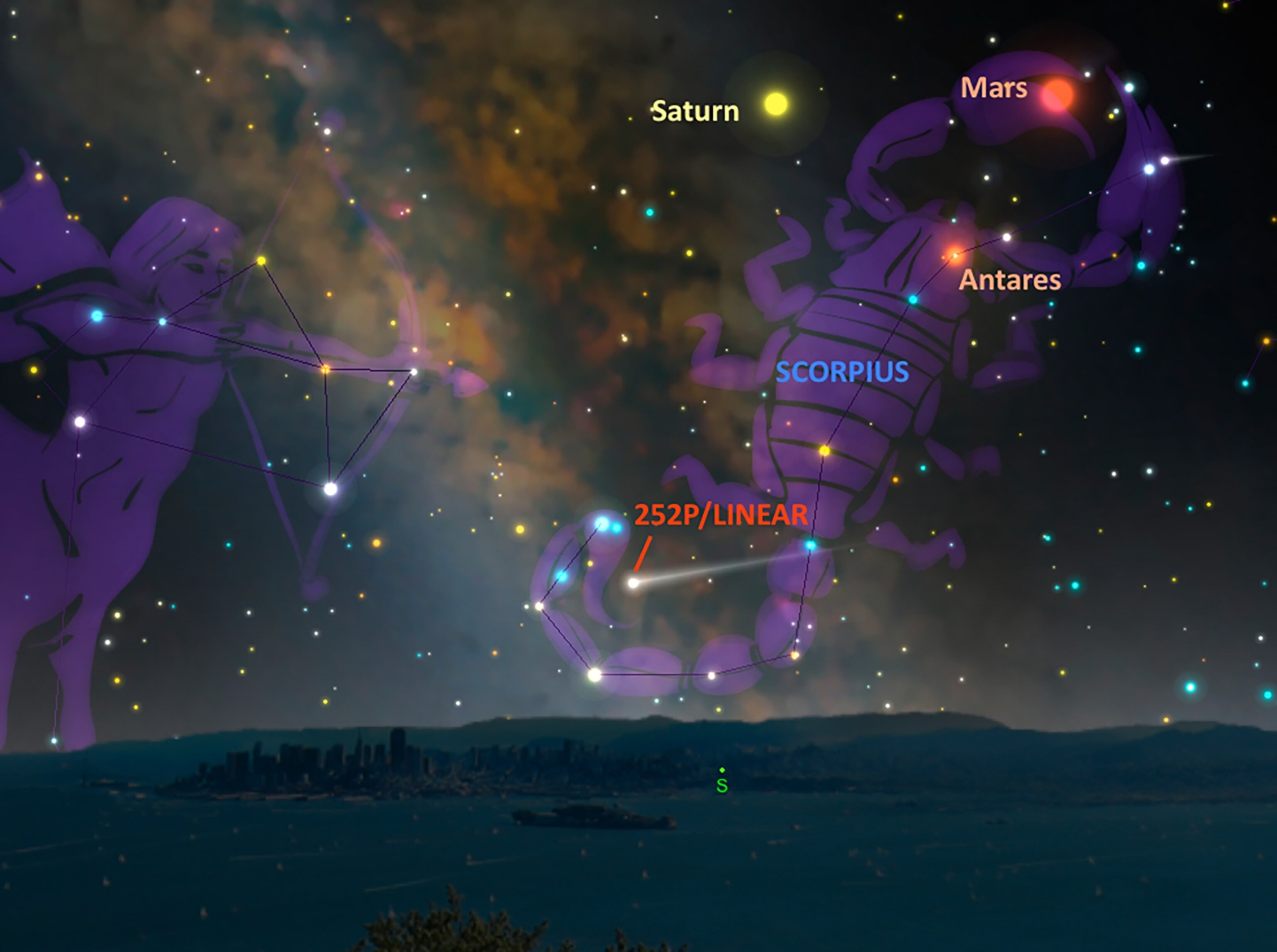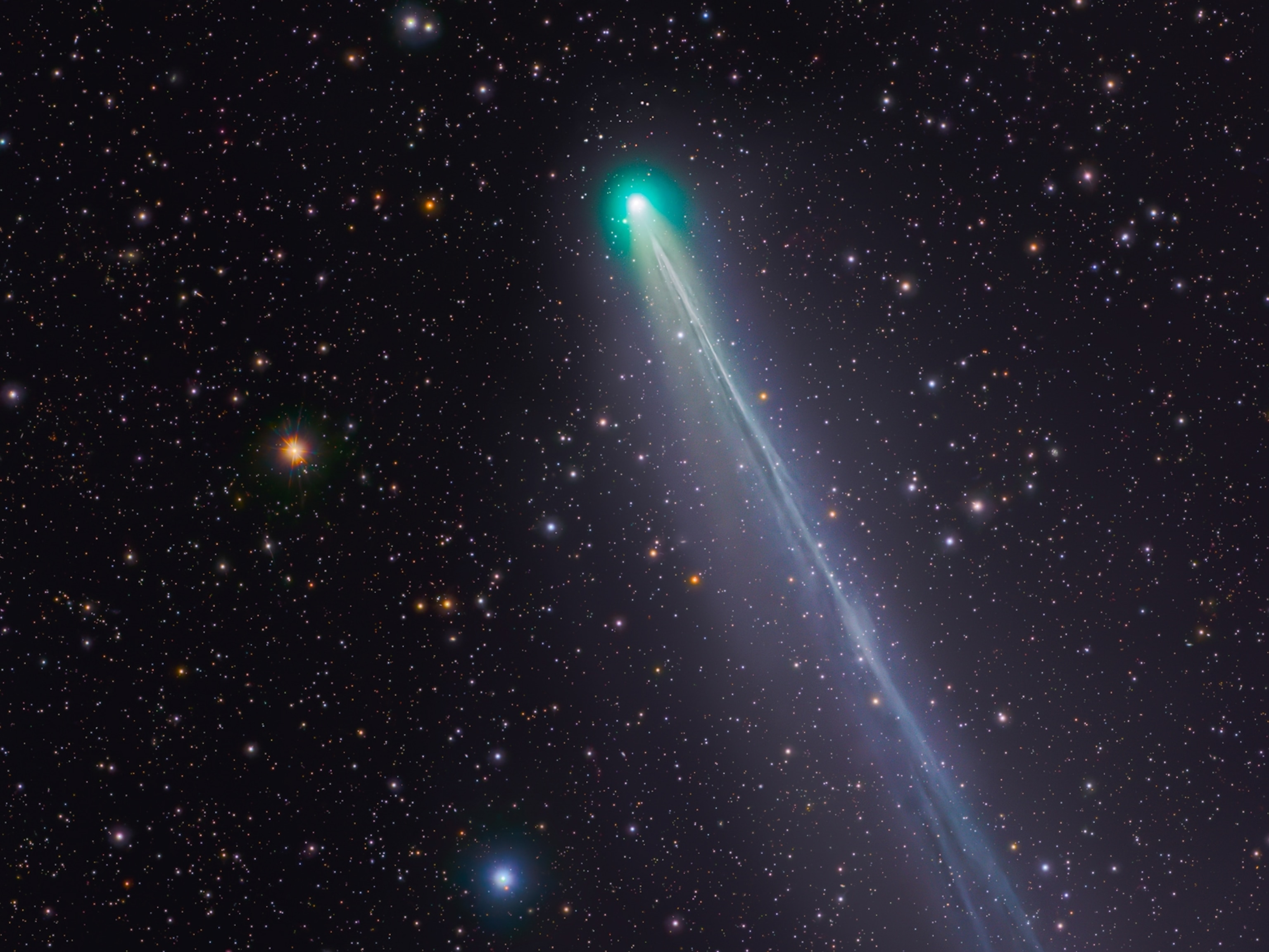
Green Comet Will Pass Near Earth—With a Twin
A rare double comet is buzzing by; here’s how to see it for yourself.
A rapidly brightening green comet is making a historically close encounter with Earth on Monday, March 21. And following right behind it like a tagalong sibling is a second, smaller comet.
The green comet, named 252P/LINEAR, is passing within 3.2 million miles (5.2 million kilometers) of Earth—about 14 times farther than the moon. While this may not sound very close, it’s actually the fifth closest comet on record. And its trailing partner will come even closer, making it the third closest in recorded history.
The larger of these visitors from the outer fringes of the solar system, estimated to be about 750 feet (230 meters) in size, was discovered by the Massachusetts Institute of Technology's Lincoln Near Earth Asteroid Research (LINEAR) survey in 2000. So far, it has been visible only through backyard telescopes in the Southern Hemisphere. But starting March 21, it’s expected to enter the high skies for observers in mid-northern latitudes, quickly gliding through the tail of constellation Scorpius in the predawn skies March 24 through 27, heading north into April.
According to observers Down Under, the comet has been unexpectedly brightening, reaching magnitude six as of March 18. This puts it on the verge of being visible to the naked eye in very dark skies, and an easy target for binoculars even in city suburbs.
Photos of the comet are also showing that it sports a distinct green hue, thanks to the vaporizing nucleus that is spewing copious amounts of carbon-based gas that tends to glow green in the vacuum of space.
Tailgater
It’s not just the comet’s proximity that’s raising eyebrows, but what’s following behind it. Turns out that 252P/LINEAR has a little sister: a smaller comet, dubbed P/2016 BA14, that appears to have a nearly identical orbit.
First spotted less than two months ago by the University of Hawaii's PanSTARRS telescope, this new object, which is about half as large, was initially thought to be an asteroid. But now astronomers think it may be a broken-off piece of 252P/LINEAR, making the siblings more like twins.

This wouldn’t be the first comet known to have fragmented into discrete chunks. Back in the summer of 1994, the astronomical world was abuzz as Comet Shoemaker-Levy 9—with at least 21 discernible pieces lined up like a series of breadcrumbs—pummeled Jupiter. The comet is thought to have been pulled apart by the strong gravitational pull of Jupiter during a previous close swing-by with the gas giant two years before.
The resulting cosmic carpet bombing 22 years ago gave Jupiter what looked like a series of black eyes. The impacts produced clearly visible scars in its upper atmosphere, some of which lasted many months.
Some theorize that something similar must have happened to 252P/LINEAR during a previous approach of the inner solar system. Perhaps a flyby of Jupiter ripped it into two pieces. Perhaps there may even be smaller pieces trailing behind.

Comet Hunting
We’ll find out when the smaller comet P/2016 BA14 makes its closest approach to Earth on March 22 at 2.1 million miles (3.4 million kilometers) at 16:00 UT (noon ET), becoming the third closest comet approach ever. But unlike its big brother, expectations are that this little guy may not get any brighter than 12th magnitude, making it visible in larger backyard telescopes. However comets are notoriously fickle, and it may unexpectedly brighten too.
If so, it will be well-placed for viewers March 25 through 27, when it races through the end of the Big Dipper. But comet watchers will have to be quick, because the comet is moving at a fast clip, covering as much as half a degree of sky in just a day—equal to the width of the full moon disk. This means that telescope viewers should see P/2016 BA14 actually move against the backdrop of fixed stars in just a one minute of observing time.

Which comet holds the record as coming closest to Earth? For that, we have to go back to the summer of 1770, when Comet Lexell swung by 1.4 million miles away (2.2 million kilometers). It must have been an amazing sight, with a comet head four times wider than the disk of the full moon and as bright as some of the brightest stars in the night sky, according to Sky and Telescope.
Finally, don’t fret if you don’t happen to have a backyard telescope or are clouded out for encounter day, because The Virtual Telescope Project will have you covered with a web broadcast showing live telescopic views of the comet's historic encounter on March 21st starting at 21:00 UT (5 p.m. ET).
Clear skies!
Follow Andrew Fazekas, the Night Sky Guy, on Twitter, Facebook, and his website.





